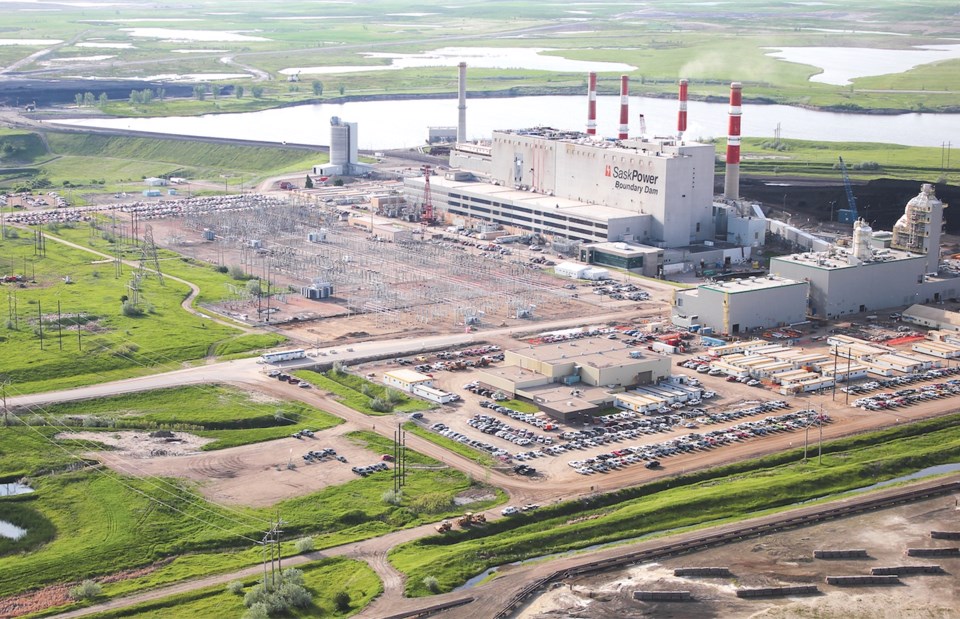Howard Matthews, the acting vice-president of power production at SaskPower, believes the carbon capture and storage (CCS) facility at the Boundary Dam Power Station has turned a corner, despite challenges it encountered during the past year.
In an interview with the Mercury last week, Matthews said the facility captured 506,000 tonnes of carbon dioxide (CO2) last year. But the type of challenges facing the facility are changing.
“The issues we were challenged with last year were really mechanical in nature, if you will,” said Matthews.
Once those mechanical issues were sorted out, the CCS facility performed better than it ever has before.
When the CCS facility opened in 2014, with technology that was the first of its kind in the world, Matthews said the problems encountered were with the chemistry, including the different amine solutions used. SaskPower had to look for solutions.
But the issues this past summer were largely for the piping for the CO2 compressor, which takes the captured CO2 and compresses it. The compressor is very large and expensive, so Matthews said it’s important for SaskPower to maintain it properly and carefully to prevent future problems.
Those compressor issues resulted in a shutdown that was much larger than originally anticipated. Originally it was happen in June and early July, so that some planned improvements in the capture process could take place. Those upgrades included adding proper valve isolations to allow crews to carry out future equipment cleaning without shutting down the entire facility. They also added other reserve pieces of equipment, such as heat exchangers, so that those can be maintained without a shutdown.
But when SaskPower started putting the CCS facility back online in July, it ran into challenges with the piping arrangement of the compressor.
“We were trying to find the staffing and the technical expertise through the summer months, which added to the challenges.”
The capture facility came back online in September.
In November, the boiler at Boundary Dam Unit 3 ran into problems, knocking it offline for several weeks.
“Because the boiler is offline for some repairs in the turbine, there’s no steam and there’s no flue gas in the CCS,” said Matthews. “By definition, if the power plant unit goes offline, it takes CCS off, but it has nothing to do with CCS.”
But the chemistry components of the facility have been performing well, he said.
The good news came in October, when the CCS facility had its best month ever, with more than 85,000 tonnes of CO2 captured.
“We were getting ready to do some particular testing in October, so we actually ran the facility up pretty much at the full load through the bulk of the month to get ready,” said Matthews. “We had to do some testing for some contractual issues, so we ran the facility pretty hard, and captured quite a bit of CO2 as a result.
“But there’s no call for that level of production,” said Matthews. “If the offtaker doesn’t require it, we really don’t need to run the facility as hard as we did in October. You can dial it back a little bit, you save on some of the costs if you will, and still have really good production in the facility.”
Since Unit 3 went back online on Dec. 19, following the issues that arose in November, it has been performing well, capturing 2,500 to 2,700 tonnes per day, close to the pace established in October.
Matthews noted that the 506,000 tonnes of CO2 captured last year is equivalent to taking 127,000 vehicles off the road each year.
The plant was online for about 60 per cent of the year, but the vast majority of the time offline was for the three-month shutdown from June to September, and the shutdown in November and December.
SaskPower netted about $5.5 million by selling the captured CO2 to Cenovus Energy for advanced oil recovery efforts.
But since the amount of captured CO2 didn’t meet the terms of SaskPower’s arrangement with Cenovus, SaskPower will have to make up the difference financially, Matthews said.
A few outages are planned for the CCS facility this year, he said, but nothing would be of “great consequence.” Matthews expects it will run steadily this year.
A decision has not yet been made on the future of Units 4 and 5 at the Boundary Dam Power Station, or the other coal-fired generating facilities in SaskPower’s fleet.
“Within SaskPower, we’re still working on recommendations internal to SaskPower, let alone the decision process that it goes through,” said Matthews.
SaskPower has been conducting analysis work on Units 4 and 5 before it can make a recommendation. The provincial government will ultimately make the final decision on whether to proceed with a retrofit of Units 4 and 5, or to proceed with another option, such as natural gas, for baseload power needs.
Matthews pointed out that SaskPower is getting close to an equivalency agreement with the federal government.
“The existing regulations are very prescriptive around retirement dates and those sorts of things,” said Matthews. “It’s very black and white … in terms of what we have to do. But under an equivalency agreement, rather than look at it on a per unit basis, we can look at our operations across the entire fleet, and that gives us quite a bit of flexibility.”
The CCS facility at Boundary Dam lowers carbon emissions for SaskPower’s generating fleet considerably.
Once the two sides reach a pact, it would give SaskPower more time to make a decision.
“It will give us quite a number of options, and a great deal of flexibility on what our future is over the next number of years,” said Matthews.
Matthews said discussions have been taking place between the federal and provincial governments for some time, and he hopes the equivalency agreement can be finalized soon.




